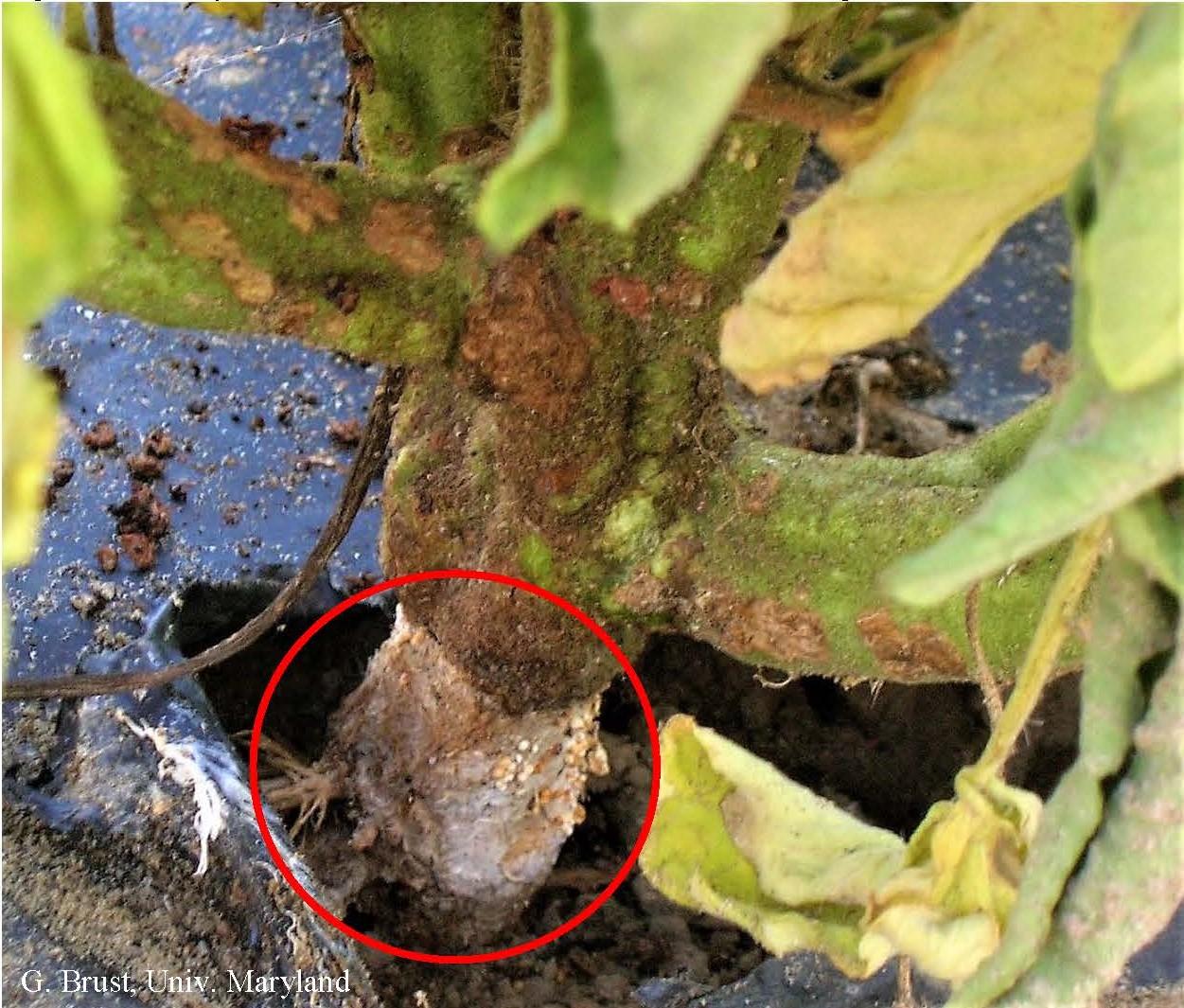Southern Blight Found Throughout Maryland this Season


Southern blight is a fungal disease that is most common in the tropics and subtropics, but also is found in the SE United States in the summer. In Maryland we usually find it in the southern part of the state in counties like St. Mary’s, Charles and Wicomico. It has been found this year in more northern counties such as Frederick, Montgomery and Baltimore. This is not too surprising when you have a record number of days of >90° F for highs and a record number of night-time temperatures of >70° F in July.
At first southern blight, which is caused by the fungus Sclerotium rolfsii, develops water-soaked lesions on lower stems or on any plant part in contact with the soil. Plants can start to turn yellow and wilt just a few days after initial infection. On tomato the most common symptom occurs on the lower stem near the soil line. The lesion will develop rapidly completely girdling the stem and under wet conditions white mycelia will develop on these stem lesions. A few days later, a large number of small spherical structures (sclerotia) that are white or tan to reddish-brown, will appear on the mat of mycelia – the sclerotia are a very indicative symptom of this particular disease (figs. 1 and 2). Oftentimes the white mycelial mats will be very thick and envelop the stem or bulb (fig. 2). Any fruit that is in contact with infested soil can become infected. Initial symptoms appear as sunken yellow areas that become water-soaked soft spots. Within 3 to 4 days the fruit will collapse and a white mycelial mat with the characteristic sclerotia will develop.
Southern blight has a wide host range, affecting vegetable and fruit hosts such as tomato, pepper, onion, beet, strawberry, lettuce, cucumber, melon, carrot and asparagus. It also will attack ornamental plants such as aster, dahlia, impatiens, black-eyed Susan, peony, daylily, rose, salvia, petunia and hosta.
The southern blight fungus is saprophytic and can grow on a variety of substrates found in soil. Freezing temperatures will kill the mycelia, but the sclerotia will persist at temperatures down to 14° F. High temperatures (>85° F), moist conditions and an acidic soil favor disease development. The germination of sclerotia occurs at pH levels of 2-5 and is actually inhibited at pH levels above seven. Sclerotia are spread by the movement of infested soil and plant material, in contaminated irrigation water, and through use of contaminated tools.
Southern blight can be difficult to manage when high levels of inoculum are in a field. Growers should not plant susceptible crops in fields that have a history of southern blight for at least 2-3 years. Rotate vegetables with corn, wheat, sorghum or small-grains. If growers bury infected plant debris and sclerotia with deep plowing it is possible to greatly reduce inoculum levels for next year. Be sure the previous crop has decomposed completely prior to planting. Maintain adequate soil pH for optimum plant growth. Lower soil pH will encourage disease development.
Fungicides containing PCNB and azoxystrobin are labeled for southern blight control on many but not all vegetables and will have varying levels of effectiveness. Work at Clemson University showed that Priaxor fungicide when directed at the base of tomato plants gave the best control of southern blight. All fungicides are more effective if applied as preventive treatments rather than after the disease is found. Do not use one active ingredient for all treatments, alternate the use of two or more different active ingredients to minimize fungicide resistance problems.